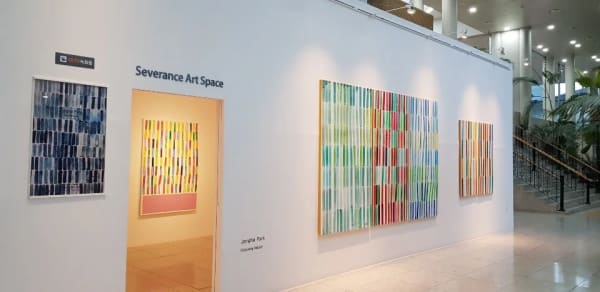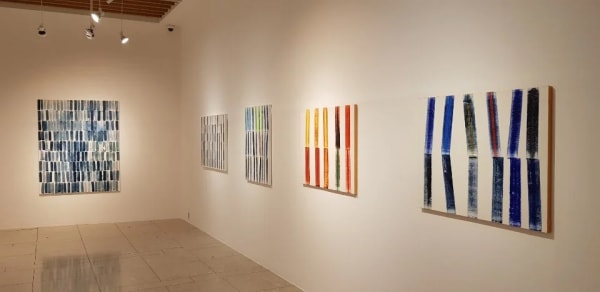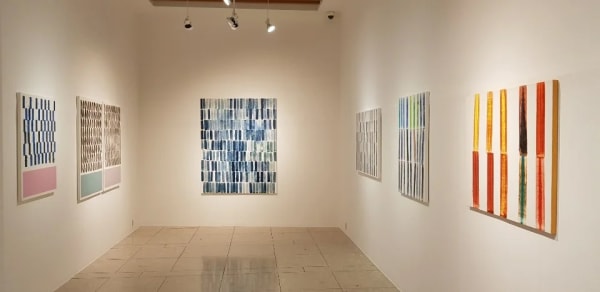박종하 : Following Nature
박종하 작가는 다채로운 색과 농도의 붓자국들을 극히 절제된 형태로 그리며 영국과 중국을 비롯한 국제무대에서 폭넓게 활동하고 있다. 작가는 연작의 제목이자 30년 넘는 작업기간동안 보여준 작품세계의 원천인 Genesis(창세기)를 통해 만물의 존재적 근원을 캔버스 위에 표현하고자 했다. 영국에서 오랫동안 공부하고 활동한 작가는 서양추상미술을 추구하지만, 그가 창조한 창세기는 동양사상 도교의 도(道)를 결합하여 모든 존재에 내제된 삶과 죽음, 영원히 변치않는 자연법칙에 대해 조화롭게 재창조하는 과정을 보여주는 것이다.
서예의 기(氣)와 동양화의 여백의 아름다움을 세련된 색감으로 융합한 박종하 작가의 붓자국들에는 그의 생명력과 예술적 에너지가 한껏 녹아들어있다. 작가는 명상을 하듯 호흡과 마음을 먼저 가다듬은 후 한 획을 내리긋는다. 그의 작품을 통해 마주한 획들은 홀로 존재할 수 없으며, 남아있는 다른 붓의 흔적과 충돌하고 화합하면서 그들만의 독특한 시적 운율을 만들어 내고 있다. 박종하 작가는 캔버스에서 획이 자리하지 않은 흰 여백을 기로 가득찬 무(無)의 공간으로 보고, 그 위로 묵묵히 붓자국을 긋는 순간을 무에서 유의 첫 발현이라고 소개하였다. 서양철학에서 ‘무’란 신이 무엇도 창조하지 않은 절대적인 상태로 신이 세상을 창조한 이후의 ‘유’와 대치되며 섞일 수 없는 개념이다. 그에 반해 동양철학에서는 상반된 특성을 가진 유와 무가 분리될 수 없는 개념이며, 이에 영향을 받은 박종하의 작업에는 그 두가지 특성이 캔버스에 공존하고 있음을 드러내고자 하는 노력이 돋보인다. 또한 각기 다른 성격의 선들이 가지고 있는 개별성을 통해 서로 상반되는 성질, 즉 당신이 없으면 내가 없고, 죽음이 없으면 탄생이 없는 변치않는 질서를 드러내고 있다. 여기에 각각의 획들은 스며듬과 번짐의 효과가 극대화되어 힘있으며 차분한 전통 동양화의 붓선을 연상시키며, 형태적 통일감을 잃지 않은 가운데 만물이 생동하는 기운을 작품에 담았다. 그의 추상표현은 가히 자유자재로 움직이는 기와 평온한 마음의 조화에서 시작되는 '문자 없는 시(詩)'라 할 수 있다.
Jongha Park has been widely active in the international art field including the United Kingdom and China. He developed an artistic practice of painting rich colors and tones of brushstrokes in an extremely restrained form. The artist attempts to express the existence of all beings on canvas through Genesis, the main title of his series and the root of his visual exploration for more than 30 years. Western abstract art has influenced Park's aesthetics after long years of education in the UK. Yet it is also notable that the Genesis created in Park's artistic world pursues Daoist feature 'dao' and shows the harmonious recreation process of the everlasting rules of nature as well as the life and death inherent in all beings.
In every line of Jongha Park's brush movements, where the colors meet with Qi in traditional calligraphy and the beauty of leaving empty space, As if meditating, the artist takes a deep breath to calm down his mind and then paints a stroke. These brushstrokes cannot exist alone; they collide and harmonize with the traces of other brushwork and creates their unique poetic rhythms. Jongha Park saw the white space on canvas as a space of full energy and mentioned that the moment he paints is the first expression of 'yu'(existence) from 'mu'(non-existence). 'Mu' refers to the absolute state of nothing before God's creation and it is a concept completely separated from 'yu' in western philosophy. Whereas in Asian philosophy 'yu' and 'mu' are conflicting ideas that coexist in this world. Influenced by the relationship of 'yu' and 'mu' in Asian philosophy, Park's artworks highlight his effort to show these two characteristics together on the canvas. Also, the individuality of his diverse strokes reveals an unchanging order - no me without you, and no birth without death. Here each stroke reminds the viewers of powerful yet calm brush lines in traditional ink painting and the artist expressed the energy of all living things without losing the sense of formality. Park's abstract visuality is 'a poem without letters,' which begins with the harmony between moving 'ki' and his tranquil mind.
University of Art London, Camberwell College of Art 서양화 석사; 판화 Fellowship; Wimbledon School of Art 석사; 추계예술대학교 서양화과 졸업.
갤러리 초이, 베이징 한모갤러리, 런던 갤러리47 등에서 개인전.
양평군립미술관, 상하이 단시 아트스페이스, 영국 포커스 갤러리, 런던주재 한국문화원 등에서 그룹전.
아트센터 나비, 관산월미술관, 잠실 롯데호텔, 한미은행 런던지점, Deutsche Bank 등에 작품 소장.





















